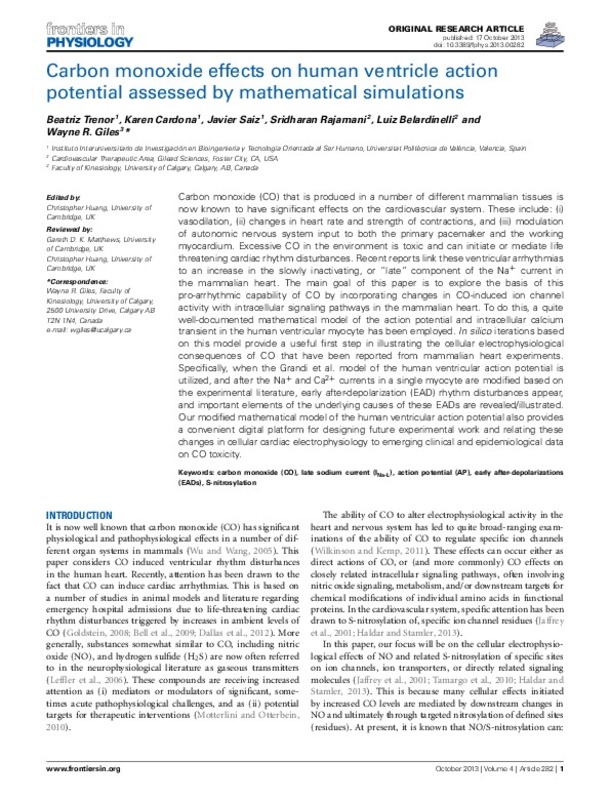Trénor Gomis, BA.; Cardona-Urrego, KE.; Saiz Rodríguez, FJ.; Rajamani, S.; Belardinelli, L.; Giles, WR. (2013). Carbon monoxide effects on human ventricle action potential assessed by mathematical simulations. Frontiers in Physiology. 4:1-11. https://doi.org/10.3389/fphys.2013.00282
Por favor, use este identificador para citar o enlazar este ítem: http://hdl.handle.net/10251/78320
|
Título:
|
Carbon monoxide effects on human ventricle action potential assessed by mathematical simulations
|
|
Autor:
|

 Trénor Gomis, Beatriz Ana
Cardona-Urrego, Karen Eliana
Trénor Gomis, Beatriz Ana
Cardona-Urrego, Karen Eliana

 Saiz Rodríguez, Francisco Javier
Rajamani, Sridharan
Belardinelli, Luiz
Giles, Wayne R.
Saiz Rodríguez, Francisco Javier
Rajamani, Sridharan
Belardinelli, Luiz
Giles, Wayne R.
|
|
Entidad UPV:
|
Universitat Politècnica de València. Instituto Interuniversitario de Investigación en Bioingeniería y Tecnología Orientada al Ser Humano - Institut Interuniversitari d'Investigació en Bioenginyeria i Tecnologia Orientada a l'Ésser Humà
Universitat Politècnica de València. Escuela Técnica Superior de Ingenieros Industriales - Escola Tècnica Superior d'Enginyers Industrials
Universitat Politècnica de València. Escuela Técnica Superior de Ingeniería del Diseño - Escola Tècnica Superior d'Enginyeria del Disseny
|
|
Fecha difusión:
|
|
|
Resumen:
|
Carbon monoxide (CO) that is produced in a number of different mammalian tissues is
now known to have significant effects on the cardiovascular system. These include: (i)
vasodilation, (ii) changes in heart rate and ...[+]
Carbon monoxide (CO) that is produced in a number of different mammalian tissues is
now known to have significant effects on the cardiovascular system. These include: (i)
vasodilation, (ii) changes in heart rate and strength of contractions, and (iii) modulation
of autonomic nervous system input to both the primary pacemaker and the working
myocardium. Excessive CO in the environment is toxic and can initiate or mediate life
threatening cardiac rhythm disturbances. Recent reports link these ventricular arrhythmias
to an increase in the slowly inactivating, or “late” component of the Na+ current in
the mammalian heart. The main goal of this paper is to explore the basis of this
pro-arrhythmic capability of CO by incorporating changes in CO-induced ion channel
activity with intracellular signaling pathways in the mammalian heart. To do this, a quite
well-documented mathematical model of the action potential and intracellular calcium
transient in the human ventricular myocyte has been employed. In silico iterations based
on this model provide a useful first step in illustrating the cellular electrophysiological
consequences of CO that have been reported from mammalian heart experiments.
Specifically, when the Grandi et al. model of the human ventricular action potential is
utilized, and after the Na+ and Ca2+ currents in a single myocyte are modified based on
the experimental literature, early after-depolarization (EAD) rhythm disturbances appear,
and important elements of the underlying causes of these EADs are revealed/illustrated.
Our modified mathematical model of the human ventricular action potential also provides
a convenient digital platform for designing future experimental work and relating these
changes in cellular cardiac electrophysiology to emerging clinical and epidemiological data
on CO toxicity.
[-]
|
|
Palabras clave:
|
Carbon monoxide (CO)
,
Late sodium current (INa-L)
,
Action potential (AP)
,
Early after-depolarizations (EADs)
,
S-nitrosylation
|
|
Derechos de uso:
|
Reconocimiento (by)
|
|
Fuente:
|
Frontiers in Physiology. (issn:
1664-042X
)
|
|
DOI:
|
10.3389/fphys.2013.00282
|
|
Editorial:
|
Frontiers Media
|
|
Versión del editor:
|
http://dx.doi.org/10.3389/fphys.2013.00282
|
|
Código del Proyecto:
|
info:eu-repo/grantAgreement/MINECO//TIN2012-37546-C03-01/ES/CORAZON HUMANO COMPLETO FISIOLOGICO VIRTUAL: MEJORAS EN EL TRATAMIENTO DE ARRITMIAS CARDIACAS ORIENTADO A PACIENTE/
info:eu-repo/grantAgreement/MITURCO//TSI-020100-2010-0469/ES/LocMoTIC. Localización del Origen de Arritmias Cardíacas Mediante Modelado y Tecnologías de la Información y Comunicaciones/
info:eu-repo/grantAgreement/UPV//PAID-06-11-2002/
info:eu-repo/grantAgreement/GVA//PROMETEO%2F2012%2F030/ES/MEJORA EN LA PREVENCION Y TRATAMIENTO DE PATOLOGIAS CARDIACAS A TRAVES DE LA MODELIZACION MULTI-ESCALA Y LA SIMULACION COMPUTACIONAL (DIGITAL HEART)/
|
|
Descripción:
|
This is an open-access article distributed
under the terms of the Creative
Commons Attribution License (CC BY).
The use, distribution or reproduction in
other forums is permitted, provided the
original author(s) or licensor are credited
and that the original publication
in this journal is cited, in accordance
with accepted academic practice. No use,
distribution or reproduction is permitted
which does not comply with these
terms.
|
|
Agradecimientos:
|
In Valencia, this work was supported by: (i) VI Plan Nacional de Investigacion Cientifica, Desarrollo e Innovacion Tecnologica from the Ministerio de Economia y Competitividad of Spain (TIN2012-37546-0O3-01) and the European ...[+]
In Valencia, this work was supported by: (i) VI Plan Nacional de Investigacion Cientifica, Desarrollo e Innovacion Tecnologica from the Ministerio de Economia y Competitividad of Spain (TIN2012-37546-0O3-01) and the European Commission (European Regional Development Funds-ERDF-FEDER)., (ii) Plan Avanza en el marco de la Accion Estrategica de Telecomunicaciones y Sociedad de la Informacion del Ministerio de Industria Turismo y Comercio of Spain (TSI-020100-2010-469), (iii) Programa deApoyo a la Investigacion y Desarrollo (PAID-06-11-2002) de la Universitat Politecnica de Valencia, (iv) Programa Prometeo (PROMETEO/2012/030) de la Conselleria d'Educacio Formacio I Ocupacio, Generalitat Valenciana, and (v) GileadSciences, Ltd. Wayne Giles acknowledges receipt of financial support in the form of a salary award (Medical Scientist) from Alberta Innovates-Health Solutions, and operating funding from the Canadian Institutes for Health Research and the Heart and Stroke Foundation of Alberta.
[-]
|
|
Tipo:
|
Artículo
|









